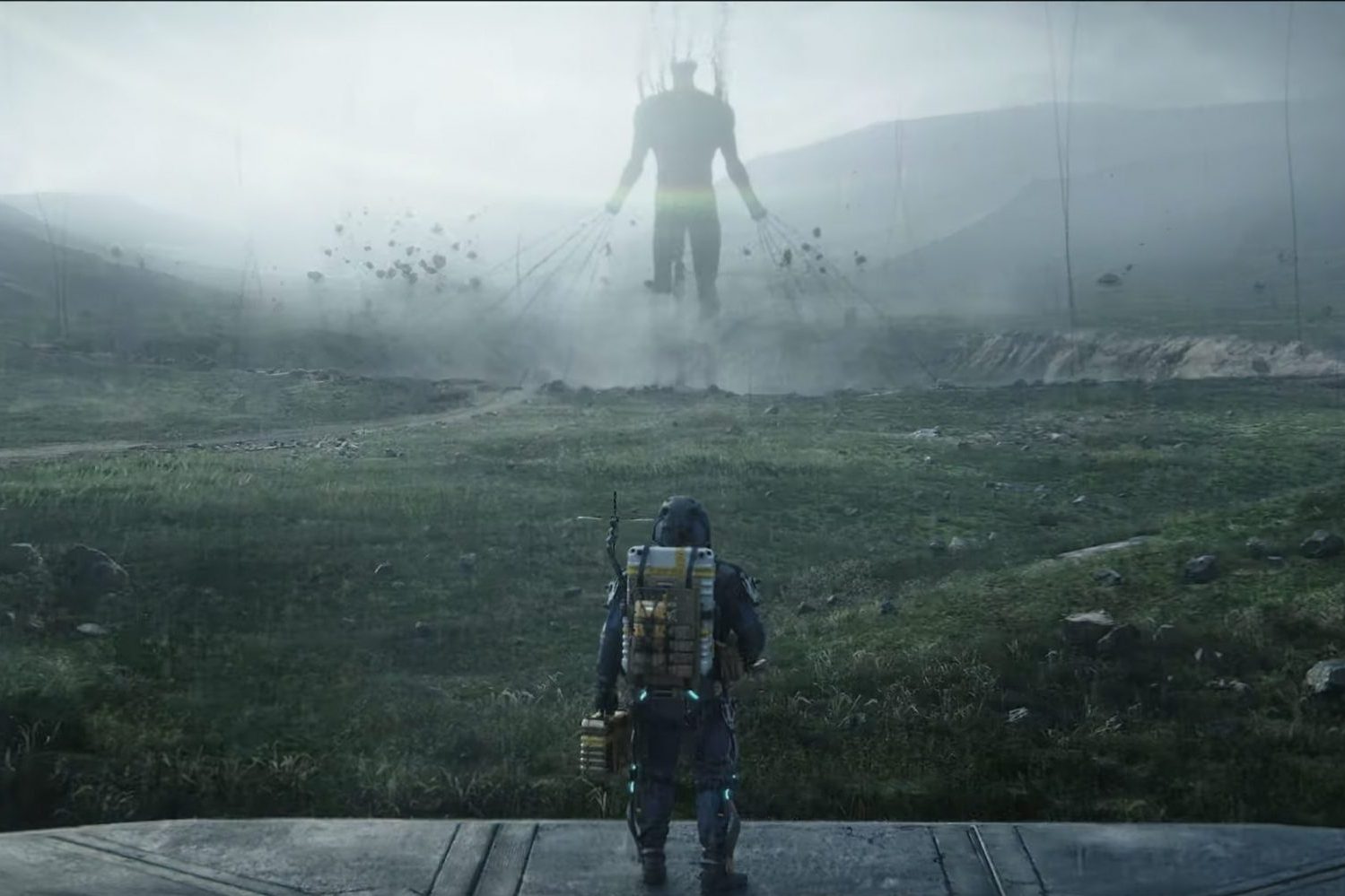When I first played Death Stranding back in November 2019, I found myself entranced by its novel depiction of a post-apocalyptic United States: a desolate landscape shaped by supernatural events that forced its inhabitants into shelter underground, divided and unable to find the unity to rebuild itself. With 505 Games’ recent PC release of Death Stranding, I revisited the title to find that its focus on isolation and connection feels especially poignant while sheltered in place. What was once a novelty now felt like a reality reflected in the game’s message and tone.
New Game
I started playing Death Stranding under circumstances that can’t be replicated right now, and I think that greatly contributed to my revisiting the game and its themes during the pandemic. As a self-proclaimed fanboy of Hideo Kojima, the enigmatic director behind the Metal Gear series and now this new intellectual property, I threw a small party for the release. A loading bar crawled across my TV as I caught up with friends and talked about what we all knew of the game, anxiously waiting for the chance to hop on a controller and play.
Everyone gathered around the screen as the opening cinematic began; we witnessed our protagonist trudge along the continental United States, delivering important packages to slowly bridge each fragmented pocket of humans together into a new “United Cities of America.” I remember wondering what it would be like to live in such isolated cities, never being able to venture out and see something new without the imminent fear of harm.
The first hour of the game sets up a lot of its world — ghostly figures called BTs and a mysterious GPS-baby, BB, sparked lots of awe, laughs, confusion and speculation among friends. Indeed, Kojima enjoys his black sheep, and Death Stranding was no exception: We had already seen plenty of Kojima’s heavy-handed allusions in lines like “Make America whole again” or the protagonist’s name, Sam Porter Bridges.
I was already enjoying Kojima’s signature fourth-wall breaks and cheesy one-liners, but it was a different experience seeing everyone react to them, too. Some (I among them) would mull over each new dialogue with such ridiculous scrutiny that we were collectively lost to a deep, geeky abyss. Some were impressed by the breathtaking Iceland-like landscapes of Death Stranding, while others were simply left asking, “What? Why did he ask that? How did Guillermo del Toro end up here?”
Looking back on it now, not many of us were actually focused on playing through Death Stranding as much as we were looking to each other’s reactions. Sure, we would still take turns slowly pushing Sam across the country, but the gameplay became less of a conscious action as conversation filled the room. Long segments of traversal became opportunities for us to talk amongst one another about things going on in school or what we wanted to do for the holidays. The game may have started as the focus of our night, but it soon gave way to building bridges and making connections of a different kind.
Are You Sure You Want to Quit?
Still, the premise of Death Stranding filled me with intrigue. I remember continuing to play well into the night after my friends had left — suddenly the eerie, empty atmosphere of Death Stranding hit me in a way that it couldn’t when surrounded by laughter and conversation. It was just Sam and I now, slowly trekking across rivers and moss-covered mountain ranges to reach our next destination. The isolation sunk in.
There has already been considerable discussion surrounding the themes of isolation in Death Stranding and how they tie into real-life events. Western instances of political division — specifically Brexit and Donald Trump’s border wall proposal — have been cited by Kojima as specific inspirations for Death Stranding and its condemnation of social estrangement. These thematic elements are usually at their apex during cutscenes, as characters reveal their often-tragic backstories and comment on Sam’s hesitance to form meaningful connections.
But as a college student with an overbooked, erratic schedule (even “erratic” may be too generous a term), the thematic power of these cutscenes felt few and far between — I could usually visit Death Stranding for only an hour at a time while classes were still in session. This translated to a slow crawl through the game’s opening chapters as we reached early 2020, and most of my playthrough was spent in a Sisyphean cycle of walking, tripping, hauling and resting as I worked toward the next plot point.
There’s little doubt that this gameplay loop was intentional — designed to be meticulous so each new accomplishment, upgrade and cutscene held an extra weight where most AAA games would trivialize them — but my experience playing Death Stranding so infrequently meant that this reward system rarely felt realized for me as a player. Sometimes I would hop into a game at the completion of a long mission I had left unfinished, feeling like I was accepting a reward for someone else’s efforts. Other times I would be stuck with the inverse, coming home from a long day of classes only to be met with yet another grind with no end in sight.
Despite Death Stranding garnering a generally positive reception at launch, its “pick up, travel, deliver” cycle has also been labeled a “chore of a game” and “a pain in the ass.” Frustrated with this gameplay loop, I could hardly differentiate the grind in Death Stranding from much of the work I was doing in real life. I wanted Kojima’s new title to be a moment of distraction after a hectic day of studying, but Death Stranding and its gameplay mechanics had an identity and purpose of their own — one that I wouldn’t see the immediate relevance of until circumstances started to change drastically.
Restart
The advent of COVID-19 and shelter-in-place orders saw many things I took for granted disappear. Throwing a party just to play a game is unfeasible under the current circumstances. Even the busy days of running around town for college classes feel firmly rooted in memory. Since moving back home in March 2020, I’ve attempted to quell the occasional onset of cabin fever with a mountain of books, movies and games — including a revisit to Death Stranding.
Parallels between the current pandemic and Death Stranding were the driving reasons behind my renewed interest in the title. Seeing as I’m still sheltered in place, the eerie sensation of walking down an empty street can feel akin to traversing the game’s desolate scenery. One can’t help but think of Sam Porter Bridges when contemplating how much our communities have relied on the delivery of commodities like food and groceries during this time, either. Some have gone so far as to label Death Stranding a prediction of this year’s events.
There has been plenty of critical discussion surrounding how the story of Death Stranding does and doesn’t function as an allegory for the COVID-19 crisis specifically, but what surprised me most in revisiting the game was how drastically my perception of its gameplay had changed. Having been cooped up in a house for months on end — where a day could hardly be differentiated from the next — the once frustrating meticulousness of plotting routes, loading cargo and taking carefully placed steps across terrain reminded me of all the normally trivial interactions that made each day unique before quarantine. Taking the bus, navigating crowds on campus, rushing to grab a coffee before class — I suddenly missed these things. Out of this feeling came a strange sort of gratitude for Death Stranding and its grind, which I once found taxing and stressful.
Getting from point A to point B in the game became an almost meditative experience. Part of this change came from the simple fact that such expansive landscapes were no longer something I could visit under the circumstances; interacting with such an environment provided a stark contrast to being holed up at home. But I noticed how many of my thoughts upon revisiting these segments were a direct inverse of my first impressions with the game. Way back in November I played as Sam after saying goodbye to a group of friends, and that contrast only elevated the game’s atmosphere of isolation. As I noted much earlier, it was “just” Sam and I, and the smaller headcount felt like a negative.
Now, when all my friends have returned home, I saw Death Stranding from a perspective more in line with those in its universe. While it was still “just” Sam and I, it became clear to me that Sam was his own person: Kojima specifically recorded animations of Norman Reedus fiddling, tapping his feet and making other small gestures to reinforce this idea, combatting a common expectation for game protagonists to act as empty vessels for the player. This differentiation between my character and I added to the headcount in my mind: The fact that Sam had a personality of his own meant that I wasn’t entirely alone as a player when facing the world of Death Stranding. My focus on how few people are present in the game shifted to an appreciation for the game’s small but memorable cast — each corny one-liner and blatant metaphor felt like a push against its indifferent, silent atmosphere.
From an excessively meta perspective (I blame you, Kojima), my experiences with Death Stranding largely mirror the bittersweet ups and downs of its own gameplay. As quarantine continues, I find the game and its thematic elements increasingly inseparable from the memory of first playing it with friends — how casually we all laughed together and talked for hours on end. Death Stranding once caught my attention because it presented a world so distant from what I knew. Now, it serves as an opportunity to reflect on a more familiar time.

















